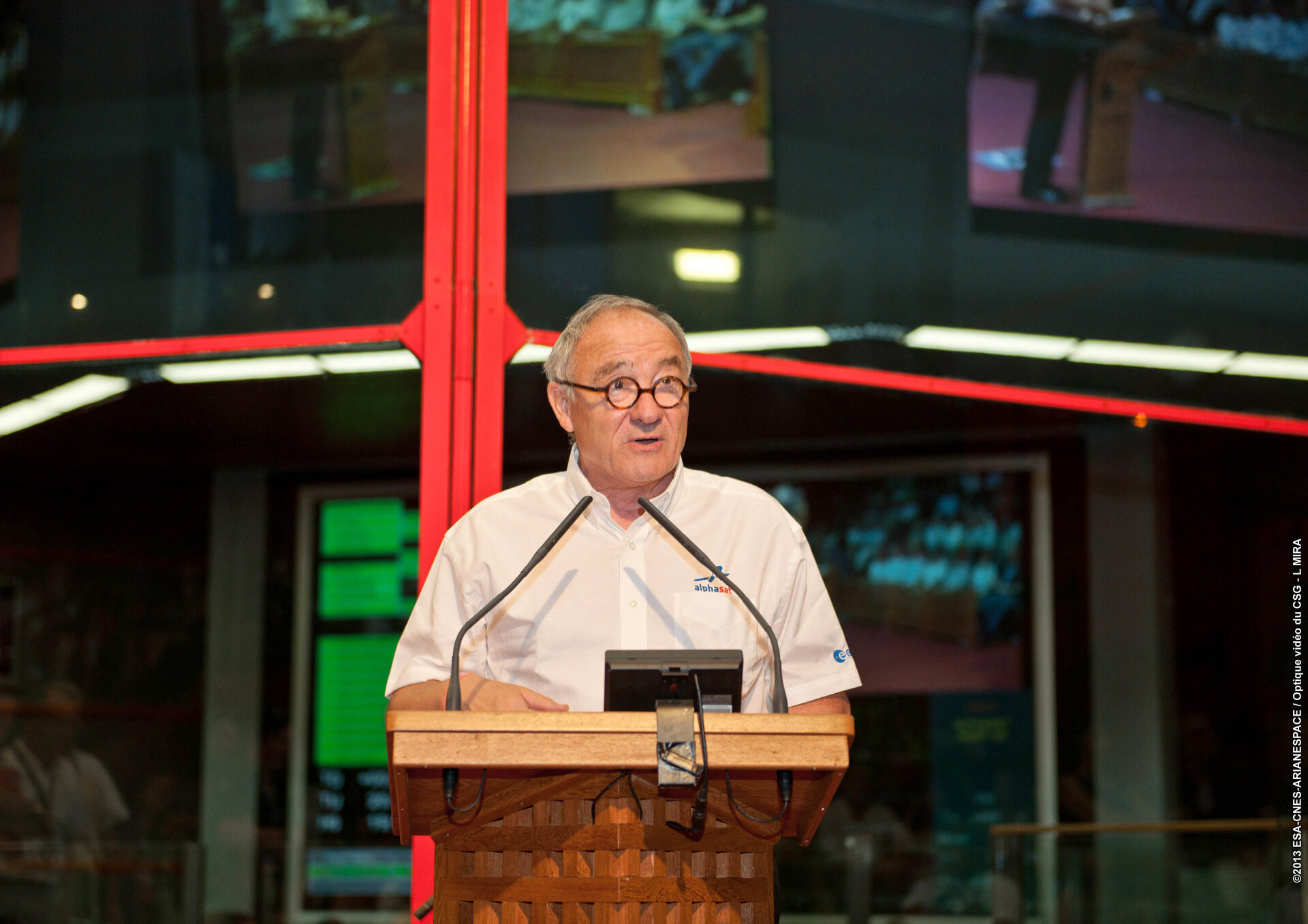ESA is not the same after Alphasat
The speech delivered by ESA DG on 25 July, 2013 to the VIP visitors who attended the Alphasat launch at CSG is now available online. The launch was successful, and the satellite is in orbit and preparing for service. The transcript offers an insight into the importance of the Alphasat project for the Agency.
Read the transcript
Welcome to CSG, a French base but with participation of all Member States. To UK Minister Willetts: you are at home here. All Member States are present in this base. This is the third time that I am here this year. The first time was on 7 May for the second launch of Vega, with Proba-V. Then on 5 June, for the ATV-4 launch on an Ariane 5, which was followed by a perfect rendezvous on 15 June, controlled by the ATV Control Center in CNES in Toulouse. Today for the launch of Alphasat, the largest telecom satellite ever developed in Europe. I will be back for launch of Gaia, which will map 1 billion stars, on a Soyuz. There will also be two Galileo satellites soon, also on a Soyuz. Yesterday, an event at the Fucino Ground Station in Italy demonstrated that the four Galileo satellites already launched from here give great accuracy, down to 2 metres. In short: we have more and more ESA missions from French Guiana.
Alphasat is innovative. It is innovative for its technology, its industrial set-up and in its partnerships. All this innovation is leading to competitiveness and growth. The benefits are now evident to all partners, in industry and institutions. They make it evident to invest in space. ESA is not the same after Alphasat
As far as innovative technology is concerned, I shall not list all innovations but as a striking example Alphasat’s microprocessor gives unprecedented flexibility in using the payload. In addition, four Technology Demonstration Payloads have been included to give flight heritage to more technologies. The Q/V band payload, with ASI, and the Laser Terminal, with DLR, have been developed in collaboration with national space agencies.
Innovation is also reflected in Alphasat’s industrial setup. First of all, there was an unprecedented industrial agreement between two primes, Astrium and Thales, for the development of the Alphabus platform. On that basis, the full industrial set-up has been developed on a full competitive process supported by Member States on the principle of fair contributions. Innovation was also present in the partnership with CNES for the platform, one of the major partnerships in the last ten years. The same can be said about the collaboration with national space agencies for TDPs. And finally about the partnership with Inmarsat, where ESA and the operator agreed to share resources, risks, but also benefits.
A partnership makes any project more complex, but it also takes the best from all partners. By combining different partners, we maximise value while sharing the risk. The relationship between ESA and Inmarsat goes back to the mid-70s when ESA was created by merging ESRO (Research) and ELDO (Launchers). This was also the origin of Inmarsat. By creating ESA, Member States created a third pillar, the one based on services and applications: telecom and meteorology. By developing new applications, new operators were created, like Eutelsat to operate ECS. The Marecs satellites for mobile telecoms and maritime communications led to the creation of Inmarsat. A similar process happened for meteorology, with the creation of Eumetsat. Inmarsat is one of the three operators “generated” by ESA.
ESA and Inmarsat have evolved since the mid-70s. We have in common the continuity of our success, which requires continued adaptation. Successful organisations have to change and keep growing. It’s never easy to change, particularly when you are successful. But it’s necessary to adapt to a changing world. It’s even better to anticipate change. It does not come naturally, which is why we have to make it happen. Leaders have to make it happen.
In a complex world we need leaders who are able to develop common objectives. Alphasat gave outstanding examples of leadership:<br>
- France, on one side, who decided to contribute to Alphabus
- The UK, through its investment in Alphasat
With these two lead countries we could go ahead with the support of other ESA Member States. ESA leaders also contributed: Giuseppe Viriglio, who brought this vision, and Magali Vaissiere, who continued it. Leadership also came from industry:
- Astrium and (at the time) Alcatel, who joined forces even though the collaboration did not come naturally
- Inmarsat has come on board thanks to several leaders. I only name Franco Carnevale and Gene Jilg
To make change happen is not enough. You have to make it successful. In order to succeed, you have to rely on expertise, mainly technical expertise. Technical expertise is the only way to manage the risks associated with space and launchers.
I would like to thank all the people who have made Alphasat a reality, from industries and space agencies. So many individuals have worked for ten years to put together these nearly 7 tonnes of technologies. Now the baby is in the hands of Ariane. Everything has been done, nothing more can be done now, but the first 30 minutes of a launch are always risky. I would like to thank you all for being here. It is special to all of us. It is unique. Enjoy the launch!


